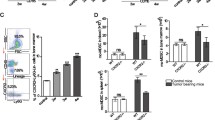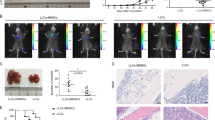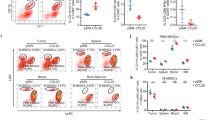Abstract
Missing in metastasis (MIM) is abundantly expressed in hematopoietic cells. Here we characterized the impact of MIM deficiency on murine bone marrow (BM) cells. Although MIM−/− cells proliferated similarly to wild type (WT), they exhibited stronger response to chemokine stromal-derived factor 1 (SDF-1), increase in surface expression of CXCR4, impaired CXCR4 internalization and constitutive activation of Rac, Cdc42 and p38. Transplantation of MIM−/− BM cells into lethally irradiated mice showed enhanced homing to BM, which was abolished when mice were pretreated with a p38 antagonist. Interestingly, MIM−/− BM cells, including hematopoietic stem and progenitor cells (HSPCs), showed two- to fivefold increase in mobilization into the peripheral blood upon treatment with AMD3100. In vitro, MIM−/− leukocytes were susceptible to AMD3100 and maintained increased response to AMD3100 for mobilization even after transfer into WT mice. MIM−/− mice had also a higher level of SDF-1 in the circulation. Our data highlighted an unprecedented role of MIM in the homeostasis of BM cells, including HSPCs, through modulation of the CXCR4/SDF-1 axis and interactions of BM leukocytes with their microenvironments.
This is a preview of subscription content, access via your institution
Access options
Subscribe to this journal
Receive 12 print issues and online access
$259.00 per year
only $21.58 per issue
Buy this article
- Purchase on Springer Link
- Instant access to full article PDF
Prices may be subject to local taxes which are calculated during checkout






Similar content being viewed by others
References
Ma Q, Jones D, Springer TA . The chemokine receptor CXCR4 is required for the retention of B lineage and granulocytic precursors within the bone marrow microenvironment. Immunity 1999; 10: 463–471.
Zou YR, Kottmann AH, Kuroda M, Taniuchi I, Littman DR . Function of the chemokine receptor CXCR4 in haematopoiesis and in cerebellar development. Nature 1998; 393: 595–599.
Sugiyama T, Kohara H, Noda M, Nagasawa T . Maintenance of the hematopoietic stem cell pool by CXCL12-CXCR4 chemokine signaling in bone marrow stromal cell niches. Immunity 2006; 25: 977–988.
Mazo IB, Massberg S, von Andrian UH . Hematopoietic stem and progenitor cell trafficking. Trends Immunol 2011; 32: 493–503.
Burger M, Glodek A, Hartmann T, Schmitt-Graff A, Silberstein LE, Fujii N et al. Functional expression of CXCR4 (CD184) on small-cell lung cancer cells mediates migration, integrin activation, and adhesion to stromal cells. Oncogene 2003; 22: 8093–8101.
Marchese A . Endocytic trafficking of chemokine receptors. Curr Opin Cell Biol 2014; 27: 72–77.
McCormick PJ, Segarra M, Gasperini P, Gulino AV, Tosato G . Impaired recruitment of Grk6 and beta-arrestin 2 causes delayed internalization and desensitization of a WHIM syndrome-associated CXCR4 mutant receptor. PloS One 2009; 4: e8102.
Kawai T, Choi U, Whiting-Theobald NL, Linton GF, Brenner S, Sechler JM et al. Enhanced function with decreased internalization of carboxy-terminus truncated CXCR4 responsible for WHIM syndrome. Exp Hematol 2005; 33: 460–468.
Balabanian K, Lagane B, Pablos JL, Laurent L, Planchenault T, Verola O et al. WHIM syndromes with different genetic anomalies are accounted for by impaired CXCR4 desensitization to CXCL12. Blood 2005; 105: 2449–2457.
Cao Y, Hunter ZR, Liu X, Xu L, Yang G, Chen J et al. The WHIM-like CXCR4 somatic mutation activates AKT and ERK, and promotes resistance to ibrutinib and other agents used in the treatment of Waldenstrom's macroglobulinemia. Leukemia 2014; 29: 169–176.
Treon SP, Cao Y, Xu L, Yang G, Liu X, Hunter ZR . Somatic mutations in MYD88 and CXCR4 are determinants of clinical presentation and overall survival in Waldenstrom macroglobulinemia. Blood 2014; 123: 2791–2796.
Neel NF, Schutyser E, Sai J, Fan GH, Richmond A . Chemokine receptor internalization and intracellular trafficking. Cytokine Growth Factor Rev 2005; 16: 637–658.
Mim C, Unger VM . Membrane curvature and its generation by BAR proteins. Trends Biochem Sci 2012; 37: 526–533.
Habermann B . The BAR-domain family of proteins: a case of bending and binding? EMBO Rep 2004; 5: 250–255.
Zhao H, Michelot A, Koskela EV, Tkach V, Stamou D, Drubin DG et al. Membrane-sculpting BAR domains generate stable lipid microdomains. Cell Rep 2013; 4: 1213–1223.
Frost A, Unger VM, De Camilli P . The BAR domain superfamily: membrane-molding macromolecules. Cell 2009; 137: 191–196.
Lee SH, Kerff F, Chereau D, Ferron F, Klug A, Dominguez R . Structural basis for the actin-binding function of missing-in-metastasis. Structure 2007; 15: 145–155.
Saarikangas J, Zhao H, Pykalainen A, Laurinmaki P, Mattila PK, Kinnunen PK et al. Molecular mechanisms of membrane deformation by I-BAR domain proteins. Curr Biol 2009; 19: 95–107.
Yu D, Zhan XH, Zhao XF, Williams MS, Carey GB, Smith E et al. Mice deficient in MIM expression are predisposed to lymphomagenesis. Oncogene 2012; 31: 3561–3568.
Lee YG, Macoska JA, Korenchuk S, Pienta KJ . MIM, a potential metastasis suppressor gene in bladder cancer. Neoplasia 2002; 4: 291–294.
Lei R, Tang J, Zhuang X, Deng R, Li G, Yu J et al. Suppression of MIM by microRNA-182 activates RhoA and promotes breast cancer metastasis. Oncogene 2014; 33: 1287–1296.
Zhang S, Qi Q . MTSS1 suppresses cell migration and invasion by targeting CTTN in glioblastoma. J Neuro-oncol 2015; 121: 425–431.
Schemionek M, Kharabi Masouleh B, Klaile Y, Krug U, Hebestreit K, Schubert C et al. Identification of the adapter molecule MTSS1 as a potential oncogene-specific tumor suppressor in acute myeloid leukemia. PloS One 2015; 10: e0125783.
Mattila PK, Salminen M, Yamashiro T, Lappalainen P . Mouse MIM, a tissue-specific regulator of cytoskeletal dynamics, interacts with ATP-actin monomers through its C-terminal WH2 domain. J Biol Chem 2003; 278: 8452–8459.
Wang Y, Liu J, Smith E, Zhou K, Liao J, Yang GY et al. Downregulation of missing in metastasis gene (MIM) is associated with the progression of bladder transitional carcinomas. Cancer Invest 2007; 25: 79–86.
Xia S, Li X, Johnson T, Seidel C, Wallace DP, Li R . Polycystin-dependent fluid flow sensing targets histone deacetylase 5 to prevent the development of renal cysts. Development 2010; 137: 1075–1084.
Saarikangas J, Mattila PK, Varjosalo M, Bovellan M, Hakanen J, Calzada-Wack J et al. Missing-in-metastasis MIM/MTSS1 promotes actin assembly at intercellular junctions and is required for integrity of kidney epithelia. J Cell Sci 2011; 124: 1245–1255.
Mattila PK, Pykalainen A, Saarikangas J, Paavilainen VO, Vihinen H, Jokitalo E et al. Missing-in-metastasis and IRSp53 deform PI(4,5)P2-rich membranes by an inverse BAR domain-like mechanism. J Cell Biol 2007; 176: 953–964.
Lin J, Liu J, Wang Y, Zhu J, Zhou K, Smith N et al. Differential regulation of cortactin and N-WASP-mediated actin polymerization by missing in metastasis (MIM) protein. Oncogene 2005; 24: 2059–2066.
Saarikangas J, Kourdougli N, Senju Y, Chazal G, Segerstrale M, Minkeviciene R et al. MIM-induced membrane bending promotes dendritic spine initiation. Dev Cell 2015; 33: 644–659.
Yu D, Zhan XH, Niu S, Mikhailenko I, Strickland DK, Zhu J et al. Murine missing in metastasis (MIM) mediates cell polarity and regulates the motility response to growth factors. PloS One 2011; 6: e20845.
Dawson JC, Legg JA, Machesky LM . Bar domain proteins: a role in tubulation, scission and actin assembly in clathrin-mediated endocytosis. Trends Cell Biol 2006; 16: 493–498.
Lapidot T, Dar A, Kollet O . How do stem cells find their way home? Blood 2005; 106: 1901–1910.
Okada S, Nakauchi H, Nagayoshi K, Nishikawa S, Miura Y, Suda T . In vivo and in vitro stem cell function of c-kit- and Sca-1-positive murine hematopoietic cells. Blood 1992; 80: 3044–3050.
Broxmeyer HE, Orschell CM, Clapp DW, Hangoc G, Cooper S, Plett PA et al. Rapid mobilization of murine and human hematopoietic stem and progenitor cells with AMD3100, a CXCR4 antagonist. J Exp Med 2005; 201: 1307–1318.
Dar A, Schajnovitz A, Lapid K, Kalinkovich A, Itkin T, Ludin A et al. Rapid mobilization of hematopoietic progenitors by AMD3100 and catecholamines is mediated by CXCR4-dependent SDF-1 release from bone marrow stromal cells. Leukemia 2011; 25: 1286–1296.
Cancelas JA, Williams DA . Rho GTPases in hematopoietic stem cell functions. Curr Opin Hematol 2009; 16: 249–254.
Yang L, Zheng Y . Cdc42: a signal coordinator in hematopoietic stem cell maintenance. Cell Cycle 2007; 6: 1445–1450.
Cancelas JA, Jansen M, Williams DA . The role of chemokine activation of Rac GTPases in hematopoietic stem cell marrow homing, retention, and peripheral mobilization. Exp Hematol 2006; 34: 976–985.
Ridley AJ, Hall A . Distinct patterns of actin organization regulated by the small GTP-binding proteins Rac and Rho. Cold Spring Harb Symp Quant Biol 1992; 57: 661–671.
Rousseau S, Dolado I, Beardmore V, Shpiro N, Marquez R, Nebreda AR et al. CXCL12 and C5a trigger cell migration via a PAK1/2-p38alpha MAPK-MAPKAP-K2-HSP27 pathway. Cell Signal 2006; 18: 1897–1905.
Bendall LJ, Baraz R, Juarez J, Shen W, Bradstock KF . Defective p38 mitogen-activated protein kinase signaling impairs chemotaxic but not proliferative responses to stromal-derived factor-1alpha in acute lymphoblastic leukemia. Cancer Res 2005; 65: 3290–3298.
Zhou L, Opalinska J, Verma A . p38 MAP kinase regulates stem cell apoptosis in human hematopoietic failure. Cell Cycle 2007; 6: 534–537.
Khurana S, Buckley S, Schouteden S, Ekker S, Petryk A, Delforge M et al. A novel role of BMP4 in adult hematopoietic stem and progenitor cell homing via Smad independent regulation of integrin-alpha4 expression. Blood 2013; 121: 781–790.
Dar AC, Shokat KM . The evolution of protein kinase inhibitors from antagonists to agonists of cellular signaling. Annu Rev Biochem 2011; 80: 769–795.
Yamagishi A, Masuda M, Ohki T, Onishi H, Mochizuki N . A novel actin bundling/filopodium-forming domain conserved in insulin receptor tyrosine kinase substrate p53 and missing in metastasis protein. J Biol Chem 2004; 279: 14929–14936.
Qualmann B, Koch D, Kessels MM . Let's go bananas: revisiting the endocytic BAR code. EMBO J 2011; 30: 3501–3515.
Henne WM, Boucrot E, Meinecke M, Evergren E, Vallis Y, Mittal R et al. FCHo proteins are nucleators of clathrin-mediated endocytosis. Science 2010; 328: 1281–1284.
Guerrier S, Coutinho-Budd J, Sassa T, Gresset A, Jordan NV, Chen K et al. The F-BAR domain of srGAP2 induces membrane protrusions required for neuronal migration and morphogenesis. Cell 2009; 138: 990–1004.
Starnes TW, Bennin DA, Bing X, Eickhoff JC, Grahf DC, Bellak JM et al. The F-BAR protein PSTPIP1 controls extracellular matrix degradation and filopodia formation in macrophages. Blood 2014; 123: 2703–2714.
Lee K, Gallop JL, Rambani K, Kirschner MW . Self-assembly of filopodia-like structures on supported lipid bilayers. Science 2010; 329: 1341–1345.
Borroni EM, Mantovani A, Locati M, Bonecchi R . Chemokine receptors intracellular trafficking. Pharmacol Ther 2010; 127: 1–8.
Lagane B, Chow KY, Balabanian K, Levoye A, Harriague J, Planchenault T et al. CXCR4 dimerization and beta-arrestin-mediated signaling account for the enhanced chemotaxis to CXCL12 in WHIM syndrome. Blood 2008; 112: 34–44.
Treon SP . How I treat Waldenstrom macroglobulinemia. Blood 2015; 126: 721–732.
Wetzler M, Talpaz M, Kleinerman ES, King A, Huh YO, Gutterman JU et al. A new familial immunodeficiency disorder characterized by severe neutropenia, a defective marrow release mechanism, and hypogammaglobulinemia. Am J Med 1990; 89: 663–672.
Kang Y, Chen BJ, Deoliveira D, Mito J, Chao NJ . Selective enhancement of donor hematopoietic cell engraftment by the CXCR4 antagonist AMD3100 in a mouse transplantation model. PloS One 2010; 5: e11316.
Author information
Authors and Affiliations
Corresponding author
Ethics declarations
Competing interests
The authors declare no conflict of interest.
Additional information
Supplementary Information accompanies this paper on the Leukemia website
Supplementary information
Rights and permissions
About this article
Cite this article
Zhan, T., Cao, C., Li, L. et al. MIM regulates the trafficking of bone marrow cells via modulating surface expression of CXCR4. Leukemia 30, 1327–1334 (2016). https://doi.org/10.1038/leu.2016.39
Received:
Revised:
Accepted:
Published:
Issue Date:
DOI: https://doi.org/10.1038/leu.2016.39
This article is cited by
-
Downregulation of MTSS1 in acute myeloid leukemia is associated with a poor prognosis, chemotherapy resistance, and disease aggressiveness
Leukemia (2021)
-
Computational analysis of the evolutionarily conserved Missing In Metastasis/Metastasis Suppressor 1 gene predicts novel interactions, regulatory regions and transcriptional control
Scientific Reports (2019)
-
Mtss1(CSC156) mutant mice fail to display efficient Mtss1 protein depletion
Leukemia (2017)
-
Mtss1 promotes maturation and maintenance of cerebellar neurons via splice variant-specific effects
Brain Structure and Function (2017)



